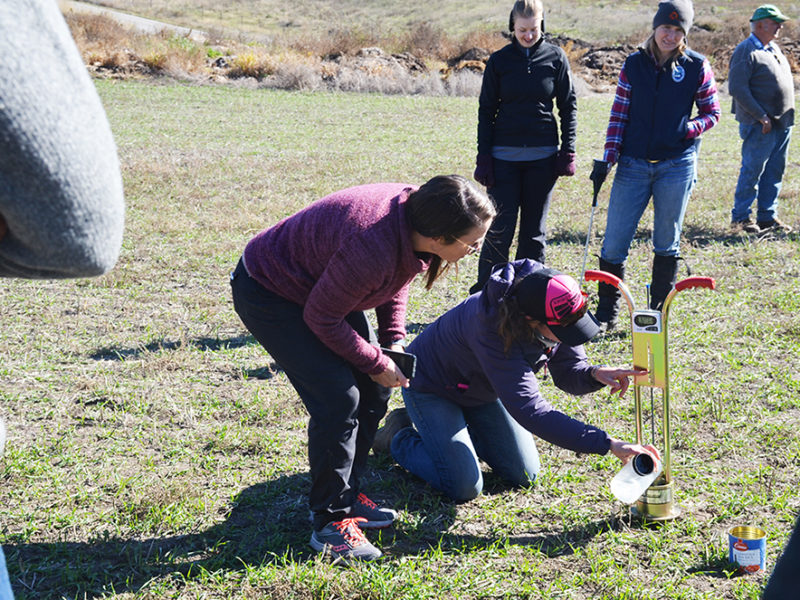ROCK CREEK – West Kootenay farmers had a field day in the hills above Rock Creek on September 10.
“We had an opportunity to view both informal and formal field trials that the farmers are developing,” says Rachael Roussin, coordinator of the Kootenay and Boundary Farm Advisors, which organized the event. “But these field days also make a space for conversation among the farmers.”
The first stop was at Doug and Erica Fossen’s cattle ranch. Classic curious farmers, the Fossens are always looking to improve the efficiency of their ranch.
This has made Doug is a fan of zero-till, the practice of seeding each year’s crop through the stubble of last year’s.
Benefits include less compaction and healthier soils because there’s no loss of organic matter or microbes.
“We’ve had spots, like on our calving grounds, where the soil was so compact we couldn’t grow anything,” he explains. “We have been zero-tilling for probably 20 years now, and those areas are not compacted anymore and the soil is getting stronger.”
Less time on the tractor also saves on the gas bill.
“We are always looking for ways to reduce our fuel bill,” he adds.
The Fossens showed a field planted to corn and intercropped with clover. The aim was to have some clover left behind for fall grazing after the corn was cut for silage. The clover was not as successful as he had hoped, however.
“My timing was a bit off, and the seeder I am using is really old,” he says. “But there should be some clover roots to stabilize the hillside soil in the spring and the new growth could give some early grazing.”
He also shared tips on growing and harvesting corn silage and corn grazing.
“I got good yields on my corn, around 7.5 tons of dry matter per acre,” he says. “I had more than I needed for silage so I left two fields for the cows to graze in December.”
He grazed an eight-acre field two years ago and he believes he got the equivalent yield in the field as if he had harvested it.
“I am hoping that each 13-acre field with about 400 cows will last 15 to 17 days,” says Fossen. “So, hopefully, we can get an extra month of grazing past when we would normally have to start feeding.”
But it’s good to have a back-up plan, he says.
“We have enough silage out in the pit to feed if everything goes wrong and it is just an ugly experiment for the neighbours to talk about,” he chuckles.
Radish rescue
Over 100 years of dry-land farming in the Rock Creek sunshine have left the grain and forage fields on Jamie Haynes’ ranch pretty compact. When it does rain, the dense soils are less able to absorb the moisture.
“After talking to the Fossens, I have transitioned to no-till methods to increase organic matter and reduce soil compaction,” explains Haynes.
A grant from the BC Agriculture and Food Climate Action Initiative’s Farm Adaptation Innovator program helped Haynes conduct an on-farm research project to see if he could improve soil function by interplanting tillage radishes while maintaining a satisfactory forage yield.
“We wanted to see if the radishes would help with water infiltration so when it does rain, the water will go in further and last longer,” explains Roussin.
Half a 60-acre field was planted with spring rye, oats and peas, and tillage radish, while the other half had no radish. Roussin coordinated the trial and Catherine Tarasoff, of Thompson Rivers University, and Agrowest Consulting provided support for research design and standardized measurements.
Tarasoff says the radishes served two purposes.
Radishes have long roots that are able to punch through the hardpan layer of soil, she explains. When the roots rot in the fall, they leave a kind of tube in the soil that allows water infiltration as well as adds organic matter.
“We found that [infiltration] where the radishes had been planted was almost twice that of the control area,” says Tarasoff. “But it’s not a silver bullet. That hardpan has taken years to build so it will take a number of plantings of radishes to break it up.”
The yields in both plots were comparable.
“We found that the yields on both the rye, oats and peas alone and the radish mix were very similar,” says Tarasoff.
However, radish planting reduced weed growth.
“The radish plantings had only half as many weeds and a more consistent yield,” she says.
That’s good for the long-term health of the field, Tarsoff points out.
“If the weeds are choked out, they will have less to seed the next year,” she says.
Low risk
On-farm research doesn’t require a lot of risk, Tarasoff notes.
“You can start with an acre just to see if something works,” she says. “And you always need an adjacent plot without the experiment so that you can compare
results.”


 Parties unite on trespass legislation
Parties unite on trespass legislation